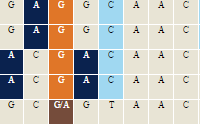| 1. |
Co-purification and localization of Munc18-1 (p67) and Cdk5 with neuronal cytoskeletal proteins. |
Bhaskar K, etal., Neurochem Int. 2004 Jan;44(1):35-44.
|
| 2. |
Effects of chronic exposure to cocaine are regulated by the neuronal protein Cdk5. |
Bibb JA, etal., Nature 2001 Mar 15;410(6826):376-80.
|
| 3. |
c-Abl tyrosine kinase modulates tau pathology and Cdk5 phosphorylation in AD transgenic mice. |
Cancino GI, etal., Neurobiol Aging. 2011 Jul;32(7):1249-61. doi: 10.1016/j.neurobiolaging.2009.07.007. Epub 2009 Aug 22.
|
| 4. |
The effect of Scutellaria baicalensis stem-leaf flavonoids on spatial learning and memory in chronic cerebral ischemia-induced vascular dementia of rats. |
Cao Y, etal., Acta Biochim Biophys Sin (Shanghai). 2016 May;48(5):437-46. doi: 10.1093/abbs/gmw024.
|
| 5. |
Pctaire1 interacts with p35 and is a novel substrate for Cdk5/p35. |
Cheng K, etal., J Biol Chem 2002 Aug 30;277(35):31988-93.
|
| 6. |
Cdk5 is involved in BDNF-stimulated dendritic growth in hippocampal neurons. |
Cheung ZH, etal., PLoS Biol. 2007 Apr;5(4):e63.
|
| 7. |
Neuronal Cell Death and Degeneration through Increased Nitroxidative Stress and Tau Phosphorylation in HIV-1 Transgenic Rats. |
Cho YE, etal., PLoS One. 2017 Jan 20;12(1):e0169945. doi: 10.1371/journal.pone.0169945. eCollection 2017.
|
| 8. |
The cyclin-dependent kinase 5 activators p35 and p39 interact with the alpha-subunit of Ca2+/calmodulin-dependent protein kinase II and alpha-actinin-1 in a calcium-dependent manner. |
Dhavan R, etal., J Neurosci. 2002 Sep 15;22(18):7879-91.
|
| 9. |
Cdk5 is involved in neuregulin-induced AChR expression at the neuromuscular junction. |
Fu AK, etal., Nat Neurosci. 2001 Apr;4(4):374-81.
|
| 10. |
Cdk5 regulates EphA4-mediated dendritic spine retraction through an ephexin1-dependent mechanism. |
Fu WY, etal., Nat Neurosci. 2007 Jan;10(1):67-76. Epub 2006 Dec 3.
|
| 11. |
Phylogenetic-based propagation of functional annotations within the Gene Ontology consortium. |
Gaudet P, etal., Brief Bioinform. 2011 Sep;12(5):449-62. doi: 10.1093/bib/bbr042. Epub 2011 Aug 27.
|
| 12. |
Rat ISS GO annotations from GOA human gene data--August 2006 |
GOA data from the GO Consortium
|
| 13. |
Cdk5-mediated inhibition of the protective effects of transcription factor MEF2 in neurotoxicity-induced apoptosis. |
Gong X, etal., Neuron. 2003 Apr 10;38(1):33-46.
|
| 14. |
Neuronal cdc2-like kinase: a cdc2-related protein kinase with predominantly neuronal expression. |
Hellmich MR, etal., Proc Natl Acad Sci U S A 1992 Nov 15;89(22):10867-71.
|
| 15. |
Microtubule association of the neuronal p35 activator of Cdk5. |
Hou Z, etal., J Biol Chem. 2007 Jun 29;282(26):18666-70. Epub 2007 May 9.
|
| 16. |
The role of thioredoxin-1 in resisting methamphetamine-induced rewarding effect. |
Huang M, etal., Behav Brain Res. 2018 Jan 30;337:280-286. doi: 10.1016/j.bbr.2017.07.047. Epub 2017 Aug 4.
|
| 17. |
p39 activates cdk5 in neurons, and is associated with the actin cytoskeleton. |
Humbert S, etal., J Cell Sci. 2000 Mar;113 ( Pt 6):975-83.
|
| 18. |
CDK5 inhibitors prevent astroglial apoptosis and reactive astrogliosis by regulating PKA and DRP1 phosphorylations in the rat hippocampus. |
Hyun HW, etal., Neurosci Res. 2017 Jun;119:24-37. doi: 10.1016/j.neures.2017.01.006. Epub 2017 Jan 30.
|
| 19. |
Balance of calcineurin Aa and CDK5 activities sets release probability at nerve terminals. |
Kim SH and Ryan TA, J Neurosci. 2013 May 22;33(21):8937-50. doi: 10.1523/JNEUROSCI.4288-12.2013.
|
| 20. |
Regulation of NMDA receptors by cyclin-dependent kinase-5. |
Li BS, etal., Proc Natl Acad Sci U S A 2001 Oct 23;98(22):12742-7.
|
| 21. |
Phosphorylation of protein phosphatase 1 by cyclin-dependent protein kinase 5 during nerve growth factor-induced PC12 cell differentiation. |
Li T, etal., J Biol Chem. 2007 Mar 2;282(9):6619-28. Epub 2007 Jan 3.
|
| 22. |
[Expression and activity of Cdk5/p35 in a rat model of trigeminal neuropathic pain]. |
Li W, etal., Shanghai Kou Qiang Yi Xue. 2010 Oct;19(5):545-8.
|
| 23. |
Ischemic stroke injury is mediated by aberrant Cdk5. |
Meyer DA, etal., J Neurosci. 2014 Jun 11;34(24):8259-67. doi: 10.1523/JNEUROSCI.4368-13.2014.
|
| 24. |
A family of human cdc2-related protein kinases. |
Meyerson M, etal., EMBO J 1992 Aug;11(8):2909-17.
|
| 25. |
Rat ISS GO annotations from MGI mouse gene data--August 2006 |
MGD data from the GO Consortium
|
| 26. |
Cyclin-dependent kinase 5 phosphorylates serine 31 of tyrosine hydroxylase and regulates its stability. |
Moy LY and Tsai LH, J Biol Chem. 2004 Dec 24;279(52):54487-93. Epub 2004 Oct 7.
|
| 27. |
Electronic Transfer of LocusLink and RefSeq Data |
NCBI rat LocusLink and RefSeq merged data July 26, 2002
|
| 28. |
Deregulation of Cdk5 in a mouse model of ALS: toxicity alleviated by perikaryal neurofilament inclusions. |
Nguyen MD, etal., Neuron 2001 Apr;30(1):135-47.
|
| 29. |
The cdk5/p35 kinase is essential for neurite outgrowth during neuronal differentiation. |
Nikolic M, etal., Genes Dev. 1996 Apr 1;10(7):816-25.
|
| 30. |
Cocaine-induced proliferation of dendritic spines in nucleus accumbens is dependent on the activity of cyclin-dependent kinase-5. |
Norrholm SD, etal., Neuroscience. 2003;116(1):19-22.
|
| 31. |
Differential roles of nuclear and cytoplasmic cyclin-dependent kinase 5 in apoptotic and excitotoxic neuronal death. |
O'Hare MJ, etal., J Neurosci. 2005 Sep 28;25(39):8954-66.
|
| 32. |
Na, K-ATPase a3 is a death target of Alzheimer patient amyloid-ß assembly. |
Ohnishi T, etal., Proc Natl Acad Sci U S A. 2015 Aug 11;112(32):E4465-74. doi: 10.1073/pnas.1421182112. Epub 2015 Jul 29.
|
| 33. |
Phosphorylation of human high molecular weight neurofilament protein (hNF-H) by neuronal cyclin-dependent kinase 5 (cdk5). |
Pant AC, etal., Brain Res. 1997 Aug 15;765(2):259-66.
|
| 34. |
Cyclin-dependent kinase 5 activity regulates pain signaling. |
Pareek TK, etal., Proc Natl Acad Sci U S A. 2006 Jan 17;103(3):791-6. doi: 10.1073/pnas.0510405103. Epub 2006 Jan 9.
|
| 35. |
KEGG Annotation Import Pipeline |
Pipeline to import KEGG annotations from KEGG into RGD
|
| 36. |
PID Annotation Import Pipeline |
Pipeline to import Pathway Interaction Database annotations from NCI into RGD
|
| 37. |
Fenugreek Seed Powder Attenuated Aluminum Chloride-Induced Tau Pathology, Oxidative Stress, and Inflammation in a Rat Model of Alzheimer's Disease. |
Prema A, etal., J Alzheimers Dis. 2017;60(s1):S209-S220. doi: 10.3233/JAD-161103.
|
| 38. |
Association of cyclin-dependent kinase 5 and neuronal activators p35 and p39 complex in early-onset Alzheimer's disease. |
Rademakers R, etal., Neurobiol Aging. 2005 Aug-Sep;26(8):1145-51. doi: 10.1016/j.neurobiolaging.2004.10.003. Epub 2004 Dec 22.
|
| 39. |
GOA pipeline |
RGD automated data pipeline
|
| 40. |
Data Import for Chemical-Gene Interactions |
RGD automated import pipeline for gene-chemical interactions
|
| 41. |
A nestin scaffold links Cdk5/p35 signaling to oxidant-induced cell death. |
Sahlgren CM, etal., EMBO J. 2006 Oct 18;25(20):4808-19. Epub 2006 Oct 12.
|
| 42. |
Cdk5 regulates the organization of Nestin and its association with p35. |
Sahlgren CM, etal., Mol Cell Biol 2003 Jul;23(14):5090-106.
|
| 43. |
Phosphorylation of FTDP-17 mutant tau by cyclin-dependent kinase 5 complexed with p35, p25, or p39. |
Sakaue F, etal., J Biol Chem. 2005 Sep 9;280(36):31522-9. Epub 2005 Jul 1.
|
| 44. |
A novel, extraneuronal role for cyclin-dependent protein kinase 5 (CDK5): modulation of cAMP-induced apoptosis in rat leukemia cells.PG - 20783-93 |
Sandal T, etal., J Biol Chem 2002 Jun 7;277(23):20783-93.
|
| 45. |
L6 myoblast differentiation is modulated by Cdk5 via the PI3K-AKT-p70S6K signaling pathway. |
Sarker KP and Lee KY, Oncogene. 2004 Aug 12;23(36):6064-70.
|
| 46. |
Regulation of membrane association and kinase activity of Cdk5-p35 by phosphorylation of p35. |
Sato K, etal., J Neurosci Res. 2007 Nov 1;85(14):3071-8. doi: 10.1002/jnr.21438.
|
| 47. |
Critical role of CDK5 and Polo-like kinase 2 in homeostatic synaptic plasticity during elevated activity. |
Seeburg DP, etal., Neuron. 2008 May 22;58(4):571-83. doi: 10.1016/j.neuron.2008.03.021.
|
| 48. |
TFP5, a Peptide Inhibitor of Aberrant and Hyperactive Cdk5/p25, Attenuates Pathological Phenotypes and Restores Synaptic Function in CK-p25Tg Mice. |
Shukla V, etal., J Alzheimers Dis. 2017;56(1):335-349. doi: 10.3233/JAD-160916.
|
| 49. |
Phosphorylation of the high molecular weight neurofilament protein (NF-H) by Cdk5 and p35. |
Sun D, etal., J Biol Chem 1996 Jun 14;271(24):14245-51.
|
| 50. |
Cdk5 is essential for synaptic vesicle endocytosis. |
Tan TC, etal., Nat Cell Biol 2003 Aug;5(8):701-10.
|
| 51. |
Phosphorylation of ATM by Cdk5 mediates DNA damage signalling and regulates neuronal death. |
Tian B, etal., Nat Cell Biol. 2009 Feb;11(2):211-8. doi: 10.1038/ncb1829. Epub 2009 Jan 18.
|
| 52. |
The neuroprotective mechanism of puerarin in the treatment of acute spinal ischemia-reperfusion injury is linked to cyclin-dependent kinase 5. |
Tian F, etal., Neurosci Lett. 2015 Jan 1;584:50-5. doi: 10.1016/j.neulet.2014.09.049. Epub 2014 Oct 7.
|
| 53. |
Inhibition of cyclin-dependent kinase 5 activity protects pancreatic beta cells from glucotoxicity. |
Ubeda M, etal., J Biol Chem. 2006 Sep 29;281(39):28858-64. Epub 2006 Aug 3.
|
| 54. |
Independent amplification of two gene clusters on chromosome 4 in rat endometrial cancer: identification and molecular characterization. |
Walentinsson A, etal., Cancer Res 2001 Nov 15;61(22):8263-73.
|
| 55. |
A dual-color FISH gene map of the proximal region of rat Chromosome 4 and comparative analysis in human and mouse. |
Walentinsson A, etal., Mamm Genome 2001 Dec;12(12):900-8.
|
| 56. |
Cdk5 activation induces hippocampal CA1 cell death by directly phosphorylating NMDA receptors. |
Wang J, etal., Nat Neurosci 2003 Oct;6(10):1039-47. Epub 2003 Sep 21.
|
| 57. |
Cdk5 and Trio modulate endocrine cell exocytosis. |
Xin X, etal., J Cell Sci. 2004 Sep 15;117(Pt 20):4739-48. Epub 2004 Aug 25.
|
| 58. |
D type cyclins associate with multiple protein kinases and the DNA replication and repair factor PCNA. |
Xiong Y, etal., Cell 1992 Oct 30;71(3):505-14.
|
| 59. |
Cdk5 inhibitor roscovitine alleviates neuropathic pain in the dorsal root ganglia by downregulating N-methyl-D-aspartate receptor subunit 2A. |
Yang L, etal., Neurol Sci. 2014 Sep;35(9):1365-71. doi: 10.1007/s10072-014-1713-9.
|
| 60. |
DARPP-32, Jack of All Trades... Master of Which? |
Yger M and Girault JA, Front Behav Neurosci. 2011 Sep 8;5:56. doi: 10.3389/fnbeh.2011.00056. eCollection 2011.
|
| 61. |
Cdk5 is required for the neuroprotective effect of transforming growth factor-ß1 against cerebral ischemia-reperfusion. |
Zhao W, etal., Biochem Biophys Res Commun. 2017 Apr 15;485(4):775-781. doi: 10.1016/j.bbrc.2017.02.130. Epub 2017 Feb 27.
|
| 62. |
Regulation of cyclin-dependent kinase 5 and calcium/calmodulin-dependent protein kinase II by phosphatidylinositol-linked dopamine receptor in rat brain. |
Zhen X, etal., Mol Pharmacol. 2004 Dec;66(6):1500-7. Epub 2004 Jul 30.
|
| 63. |
A Cdk5 inhibitory peptide reduces tau hyperphosphorylation and apoptosis in neurons. |
Zheng YL, etal., EMBO J. 2005 Jan 12;24(1):209-20. Epub 2004 Dec 9.
|
| 64. |
Increased Cdk5/p35 activity in the dentate gyrus mediates depressive-like behaviour in rats. |
Zhu WL, etal., Int J Neuropsychopharmacol. 2012 Jul;15(6):795-809. doi: 10.1017/S1461145711000915. Epub 2011 Jun 20.
|
| 65. |
Activation of latent cyclin-dependent kinase 5 (Cdk5)-p35 complexes by membrane dissociation. |
Zhu YS, etal., J Neurochem. 2005 Sep;94(6):1535-45. Epub 2005 Jun 30.
|






































